Improvement of the Photosynthetic Characteristics and Yield of Wheat by Regulating the Proportion of Nitrogen Fertilizer Base and Topdressing
Abstract
1. Introduction
2. Materials and Methods
2.1. Overview of the Experimental Site
2.2. Experimental Design
2.3. Measurement Items and Methods
2.3.1. Leaf Region Index (LAI) and Relative Chlorophyll Content (SPAD)
2.3.2. Photosynthetic Enzyme Activity
2.3.3. Gas Exchange
2.3.4. Leaf Chlorophyll Fluorescence
2.3.5. Grain Yield
2.4. Data Analysis
3. Results
3.1. Leaf Area Index (LAI) and Relative Chlorophyll Content (SPAD)
3.2. Activities of Key Photosynthetic Enzymes in Flag Leaves
3.3. Gas Exchange Parameters
3.4. Chlorophyll Fluorescence Parameters
3.5. The Relationship Between Photosynthetic Physiological Parameters and Grain Yield
3.5.1. Grain Yield
3.5.2. Correlation and Pathway Analysis of Photosynthetic Physiological Parameters with Yield Formation
4. Discussion
4.1. Effects of Nitrogen Fertilizer Basal and Topdressing Mode on Photosynthetic Physiology of Wheat Leaves
4.2. Effects of Nitrogen Fertilizer Basal and Topdressing Mode on Yield Formation in Wheat
5. Conclusions
Author Contributions
Funding
Data Availability Statement
Acknowledgments
Conflicts of Interest
Abbreviations
| Abbreviations | Meaning |
| Ci | Intercellular CO2 concentration |
| Fv/Fm | Maximum photochemical efficiency |
| Gs | Stomatal conductance |
| LAI | Leaf region index |
| PEPC | Phosphoenolpyruvate carboxylase |
| Pn | Net photosynthetic rate |
| RuBPC | Ribulose-1,5-diphosphate ribulose carboxylase |
| SPAD | Relative chlorophyll content |
| Tr | Transpiration rate |
| ΦPSⅡ | Actual photochemical efficiency |
References
- Sun, Z.; Geng, W.; Ren, B.; Zhao, B.; Liu, P.; Zhang, J. Responses of the photosynthetic characteristics of summer maize to shading stress. J. Agron. Crop Sci. 2023, 209, 330–344. [Google Scholar]
- Wu, D.; Zhang, Y.; Gu, W.; Feng, Z.; Xiu, L.; Zhang, W.; Chen, W. Long term co-application of biochar and fertilizer could increase soybean yield under continuous cropping: Insights from photosynthetic physiology. J. Sci. Food Agric. 2024, 104, 3113–3122. [Google Scholar]
- Li, S.; Li, Z.; Bi, X.; Feng, B.; Wang, Z.; Wang, F.; Si, J.; Shi, J.; Liu, K. Nitrogen fertilizer management on wheat yield and nitrogen utilization. J. Plant Nutr. 2022, 45, 1953–1960. [Google Scholar]
- Tian, H.; Zhou, Q.; Liu, W.; Zhang, J.; Chen, Y.; Jia, Z.; Shao, W.; Wang, H. Responses of photosynthetic characteristics of oat flag leaf and spike to drought stress. Front. Plant Sci. 2022, 13, 917528. [Google Scholar]
- Zahra, N.; Hafeez, M.B.; Kausar, A.; Al Zeidi, M.; Asekova, S.; Siddique, K.H.; Farooq, M. Plant photosynthetic responses under drought stress: Effects and management. J. Agron. Crop Sci. 2023, 209, 651–672. [Google Scholar]
- Wan, W.; Zhao, Y.; Wang, Z.; Li, L.; Jing, J.; Lv, Z.; Diao, M.; Li, W.; Jiang, G.; Wang, X.; et al. Mitigation fluctuations of inter-row water use efficiency of spring wheat via narrowing row space in enlarged lateral space drip irrigation systems. Agric. Water Manag. 2022, 274, 107958. [Google Scholar]
- Lv, Z.; Diao, M.; Li, W.; Cai, J.; Zhou, Q.; Wang, X.; Dai, T.; Cao, W.; Jiang, D. Impacts of lateral spacing on the spatial variations in water use and grain yield of spring wheat plants within different rows in the drip irrigation system. Agric. Water Manag. 2019, 212, 252–261. [Google Scholar]
- Pal, N.; Saini, D.; Kumar, S. Breaking yield ceiling in wheat: Progress and future prospects. In Wheat; IntechOpen: London, UK, 2022. [Google Scholar]
- Yan, S.; Wu, Y.; Fan, J.; Zhang, F.; Guo, J.; Zheng, J.; Wu, L. Quantifying grain yield, protein, nutrient uptake and utilization of winter wheat under various drip fertigation regimes. Agric. Water Manag. 2022, 261, 107380. [Google Scholar]
- Zain, M.; Si, Z.; Ma, H.; Cheng, M.; Khan, A.; Mehmood, F.; Duan, A.; Sun, C. Developing a tactical irrigation and nitrogen fertilizer management strategy for winter wheat through drip irrigation. Front. Plant Sci. 2023, 14, 1231294. [Google Scholar]
- Shu, Q.J.; Fang, Z. Zero growth of chemical fertilizer and pesticide use: China’s objectives, progress and challenges. J. Resour. Ecol. 2018, 9, 50–58. [Google Scholar]
- Kubar, M.S.; Wang, C.; Noor, R.S.; Feng, M.; Yang, W.; Kubar, K.A.; Soomro, K.; Yang, C.; Sun, H.; Hasan, M.; et al. Nitrogen fertilizer application rates and ratios promote the biochemical and physiological attributes of winter wheat. Front. Plant Sci. 2022, 13, 3888. [Google Scholar]
- Wang, Q.; Li, F.; Zhang, E.; Li, G.; Vance, M. The effects of irrigation and nitrogen application rates on yield of spring wheat (longfu-920), and water use efficiency and nitrate nitrogen accumulation in soil. Aust. J. Crop Sci. 2012, 6, 662–672. [Google Scholar]
- Bhattacharya, A. Global climate change and its impact on agriculture. Changing climate and resource use efficiency in plants 2019, 1, 1–50. [Google Scholar]
- Gao, J.; Zhang, X.; Luo, J.; Zhu, P.; Lindsey, S.; Gao, H.; Li, Q.; Peng, C.; Zhang, L.; Xu, L.; et al. Changes in soil fertility under partial organic substitution of chemical fertilizer: A 33-year trial. J. Sci. Food Agric. 2023, 103, 7424–7433. [Google Scholar]
- Wang, J.; Hussain, S.; Sun, X.; Zhang, P.; Javed, T.; Dessoky, E.S.; Ren, X.; Chen, X. Effects of nitrogen application rate under straw incorporation on photosynthesis, productivity and nitrogen use efficiency in winter wheat. Front. Plant Sci. 2022, 13, 862088. [Google Scholar]
- Ji, J.; Liu, J.; Chen, J.; Niu, Y.; Xuan, K.; Jiang, Y.; Jia, R.; Wang, C.; Li, X. Optimization of topdressing for winter wheat by accurate growth monitoring and improved production estimation. Remote Sens. 2021, 13, 2349. [Google Scholar] [CrossRef]
- Shi, Y.; Yu, Z.; Wang, D.; Li, Y.; Wang, X. Effects of nitrogen rate and ratio of base fertilizer and topdressing on uptake, translocation of nitrogen and yield in wheat. Front. Agric. 2007, 1, 142–148. [Google Scholar]
- Wu, W.; Ma, B.; Fan, J.; Sun, M.; Yi, Y.; Guo, W.; Voldeng, H. Management of nitrogen fertilization to balance reducing lodging risk and increasing yield and protein content in spring wheat. Field Crop Res. 2019, 241, 107584. [Google Scholar]
- Rajaona, A.M.; Brueck, H.; Asch, F. Leaf gas exchange characteristics of Jatropha as affected by nitrogen supply, leaf age and atmospheric vapour pressure deficit. J. Agron. Crop Sci. 2013, 199, 144–153. [Google Scholar]
- Hamani, A.K.M.; Abubakar, S.A.; Si, Z.; Kama, R.; Gao, Y.; Duan, A. Suitable split nitrogen application increases grain yield and photosynthetic capacity in drip-irrigated winter wheat (Triticum aestivum L.) under different water regimes in the North China Plain. Front. Plant Sci. 2023, 13, 1105006. [Google Scholar]
- Shehab, A.E.S.A.E.; Guo, Y. Effects of nitrogen fertilization and drought on hydrocyanic acid accumulation and morpho-physiological parameters of sorghums. J. Sci. Food Agric. 2021, 101, 3355–3365. [Google Scholar] [PubMed]
- Zhang, X.; Du, S.; Xu, Y.; Qiao, Y.; Cao, C.; Li, W. Response of canopy photosynthesis, grain quality, and harvest index of wheat to different nitrogen application methods. Plants 2022, 11, 2328. [Google Scholar] [CrossRef]
- Zhang, H.; Zhao, Q.; Wang, Z.; Wang, L.; Li, X.; Fan, Z.; Zhang, Y.; Li, J.; Gao, X.; Shi, J.; et al. Effects of nitrogen fertilizer on photosynthetic characteristics, biomass, and yield of wheat under different shading conditions. Agronomy 2021, 11, 1989. [Google Scholar] [CrossRef]
- Zhou, Q.; Wang, Q.; Zheng, Z.; Liu, W. Carbon neutrality and ecological remediation in agricultural grain production. J. Agric. Environ. Sci. 2023, 42, 1–10. [Google Scholar]
- Liu, Z.; Gao, J.; Gao, F.; Liu, P.; Zhao, B.; Zhang, J. Photosynthetic characteristics and chloroplast ultrastructure of summer maize response to different nitrogen supplies. Front. Plant Sci. 2018, 9, 576. [Google Scholar]
- Tang, W.; Guo, H.; Baskin, C.C.; Xiong, W.; Yang, C.; Li, Z.; Song, H.; Wang, T.; Yin, J.; Wu, X.; et al. Effect of light intensity on morphology, photosynthesis and carbon metabolism of alfalfa (Medicago sativa) seedlings. Plants 2022, 11, 1688. [Google Scholar] [CrossRef]
- Ting, J.P.; Osmond, I.B. Photosynthetic phosphoenolpyrurate carboxylases. Plant Physiol. 1973, 51, 439–447. [Google Scholar]
- Champigny, M.L.; Foyer, C. Nitrate activation of cytosolic protein kinases diverts photosynthetic carbon from sucrose to amino acid biosynthesis: Basis for a new concept. Plant Physiol. 1992, 100, 7–12. [Google Scholar]
- Ma, D.; Guo, T.; Song, X.; Wang, C.; Han, Q.; Yue, Y. Effects of nitrogen fertilizer application on RuBP carboxylase activity and chlorophyll fluorescence parameters in flag leaves of winter wheat. Acta Bot. Boreali-Occident. Sin. 2010, 30, 2197–2202. [Google Scholar]
- Gonzalez, N.; Vanhaeren, H.; Inzé, D. Leaf size control: Complex coordination of cell division and expansion. Trends Plant Sci. 2012, 17, 332–340. [Google Scholar]
- Long, S.P.; Zhu, X.G.; Naidu, S.L.; Ort, D.R. Can improvement in photosynthesis increase crop yields? Plant Cell Environ. 2006, 29, 315–330. [Google Scholar] [CrossRef] [PubMed]
- Mu, Q.; Dong, M.; Xu, J.; Cao, Y.; Ding, Y.; Sun, S.; Cai, H. Photosynthesis of winter wheat effectively reflected multiple physiological responses under short-term drought-rewatering conditions. J. Sci. Food Agric. 2022, 102, 2472–2483. [Google Scholar] [PubMed]
- Kubar, M.S.; Alshallash, K.S.; Asghar, M.A.; Feng, M.; Raza, A.; Wang, C.; Saleem, K.; Ullah, A.; Yang, W.; Kubar, K.; et al. Improving winter wheat photosynthesis, nitrogen use efficiency, and yield by optimizing nitrogen fertilization. Life 2022, 12, 1478. [Google Scholar] [CrossRef] [PubMed]
- Effah, Z.; Li, L.; Xie, J.; Liu, C.; Xu, A.; Karikari, B.; Anwar, K.; Zeng, M. Regulation of nitrogen metabolism, photosynthetic activity, and yield attributes of spring wheat by nitrogen fertilizer in the semi-arid Loess Plateau region. J. Plant Growth Regul. 2023, 42, 1120–1133. [Google Scholar] [CrossRef]
- Lin, Y.; Hu, Y.; Ren, C.; Guo, L.; Wang, C.; Jiang, Y.; Wang, X.; Phendukani, H.; Zeng, Z. Effects of nitrogen application on chlorophyll fluorescence parameters and leaf gas exchange in naked oat. J. Integr. Agric. 2013, 12, 2164–2171. [Google Scholar]
- Xu, X.; Zhang, J.; Dai, J.; Xi, Y.; Li, X.; Wang, L.; Li, W.; Sun, H. Effects of base-topdressing ratio of nitrogen fertilizer on nitrogen absorption and leaf senescence of cotton under different planting patterns. Chin. J. Eco-Agric. 2025, 33, 1–14. [Google Scholar]
- Liu, J.; Si, Z.; Li, S.; Wu, L.; Zhang, Y.; Wu, X.; Cao, H.; Gao, Y.; Duan, A. Effects of water and nitrogen rate on grain-filling characteristics under high-low seedbed cultivation in winter wheat. J. Integr. Agric. 2023, 23, 4018–4031. [Google Scholar]
- Azam, B.; Mir, A.M.S.; Ali, E. Effects of salt and nitrogen on physiological indices and carbon isotope discrimination of wheat cultivars in the northeast of Iran. J Integr Agric. 2020, 19, 656–667. [Google Scholar]
- Ma, S.; Wang, G.; Su, S.; Lu, J.; Ren, T.; Cong, R.; Lu, Z.; Zhang, Y.; Liao, S.; Li, X. Effects of optimized nitrogen fertilizer management on the yield, nitrogen uptake, and ammonia volatilization of direct-seeded rice. J. Sci. Food Agric. 2023, 103, 4553–4561. [Google Scholar] [CrossRef]
- Racker, E. Ribulose diphosphate carboxylase from spinach leaves. In Methods in Enzymology; Colowick, S.P., Kaplan, N.O., Eds.; Academic Press: New York, NY, USA, 1962; pp. 266–278. [Google Scholar]
- Godlewska, K.; Pacyga, P.; Michalak, I.; Biesiada, A.; Szumny, A.; Pachura, N.; Piszcz, U. Field-scale evaluation of botanical extracts effect on the yield, chemical composition and antioxidant activity of celeriac (Apium graveolens L. var. rapaceum). Molecules 2020, 25, 4212. [Google Scholar] [CrossRef]
- He, L.; Ren, X.; Wang, Y.; Liu, B.; Zhang, H.; Liu, W.; Feng, W.; Guo, T. Comparing methods for estimating leaf area index by multi-angular remote sensing in winter wheat. Sci. Rep. 2020, 10, 13943. [Google Scholar] [CrossRef] [PubMed]
- Zhang, H.; Duan, Z.; Li, Y.; Zhao, G.; Zhu, S.; Fu, W.; Peng, T.; Zhao, Q.; Svanberg, S.; Hu, J. Vis/NIR reflectance spectroscopy for hybrid rice variety identification and chlorophyll content evaluation for different nitrogen fertilizer levels. R. Soc. Open Sci. 2019, 6, 191132. [Google Scholar] [PubMed]
- Zhang, Y.; Yu, S.; Li, C.; Wang, Y.; Diao, Z. Response characteristics of plant growth and leaf photochemical activity of sugar beet seedlings to different nitrogen application leaves. J. Nuclear Agric. Sci. 2013, 27, 1391–1400. [Google Scholar]
- Shi, X.; Yu, Z.; Zhao, J.; Shi, Y.; Wang, X. Effect of nitrogen application rateon photosynthetic characteristics, dry matter accumulation and distribution and yield of high-yielding winter wheat. J. Triticeae Crops 2021, 41, 713–721. [Google Scholar]
- Yao, C.; Li, J.; Zhang, Z.; Liu, Y.; Wang, Z.; Sun, Z.; Zhang, Y. Improving wheat yield, quality and resource utilization efficiency through nitrogen management based on micro-sprinkler irrigation. Agric. Water Manag. 2023, 282, 108277. [Google Scholar]
- Zhang, Z.; Zhang, Y.; Shi, Y.; Yu, Z. Optimized split nitrogen fertilizer increase photosynthesis, grain yield, nitrogen use efficiency and water use efficiency under water-saving irrigation. Sci. Rep. 2020, 10, 20310. [Google Scholar] [CrossRef]
- Qiang, B.; Zhou, W.; Zhong, X.; Fu, C.; Cao, L.; Zhang, Y.; Jin, X. Effect of nitrogen application levels on photosynthetic nitrogen distribution and use efficiency in soybean seedling leaves. J. Plant Physiol. 2023, 287, 154051. [Google Scholar] [CrossRef]
- Kubar, M.S.; Feng, M.; Sayed, S.; Shar, A.H.; Rind, N.A.; Ullah, H.; Kalhoro, S.; Xie, Y.; Yang, C.; Yang, W.; et al. Agronomical traits associated with yield and yield components of winter wheat as affected by nitrogen managements. Saudi J. Biol. Sci. 2021, 28, 4852–4858. [Google Scholar] [CrossRef]
- Li, T.; Xie, Y.; Hong, J.; Feng, Q.; Sun, C.; Wang, Z. Effects of nitrogen application rate on photosynthetic characteristics, yield, and nitrogen utilization in rainfed winter wheat in southern Shanxi. Acta Agron. Sin. 2013, 39, 704–711. [Google Scholar]
- Mu, Y.; Mi, M.; Sun, L.; Zhu, R.; Kang, J. Effect of nitrogen dressing ratios on its photosynthesis after anthesis of spring wheat under high temperature. Southwest Agric. Sci. 2017, 30, 1027–1034. [Google Scholar]
- Song, X.; Zhou, G.; Ma, B.; Wu, W.; Ahmad, I.; Zhu, G.; Yan, W.; Jiao, X. Nitrogen application improved photosynthetic productivity, chlorophyll fluorescence, yield and yield components of two oat genotypes under saline conditions. Agronomy 2019, 9, 115. [Google Scholar] [CrossRef]
- Hou, P.; Hu, C.; Yu, J.; Gao, Q.; Zhou, M.; Gao, L.; Jiang, D.; Dai, T.; Tian, Z. Increasing Topdressing Ratio of Nitrogen Fertilizer Improves Grain Yield and Nitrogen Use Efficiency of Winter Wheat Under Winter and Spring Night-Warming. J. Soil Sci. Plant Nutr. 2024, 24, 3459–3473. [Google Scholar]
- Liu, Y.; Han, M.; Zhou, X.; Li, W.; Du, C.; Zhang, Y.; Zhang, Y.; Sun, Z.; Wang, Z. Optimizing nitrogen fertilizer application under reduced irrigation strategies for winter wheat of the north China plain. Irrig. Sci. 2022, 40, 255–265. [Google Scholar]
- Noor, H.; Ding, P.; Ren, A.; Sun, M.; Gao, Z. Effects of Nitrogen Fertilizer on Photosynthetic Characteristics and Yield. Agronomy 2023, 13, 1550. [Google Scholar] [CrossRef]
- Liu, T.; Lu, J.; Ren, T.; Li, X.; Cong, R. Relationship between photosynthetic nitrogen use efficiency and nitrogen allocation in photosynthetic apparatus of winter oilseed rape under different nitrogen levels. J. Plant Nutr. 2016, 22, 518–524. [Google Scholar]
- Jiang, L.; Zheng, D.; Wang, Y.; Yao, L.; Shao, Y.; Li, C.X. The effects of nitrogen fertilizer application period and basal to topdressing ratio on wheat leaf physiology and yield in the central Henan region. J. Wheat Crops 2010, 30, 149–153. [Google Scholar]
- Cui, H.; Luo, Y.; Li, C.; Chang, Y.; Jin, M.; Li, Y.; Wang, Z. Effects of nitrogen forms on nitrogen utilization, yield, and quality of two wheat varieties with different gluten characteristics. Eur. J. Agron. 2023, 149, 126919. [Google Scholar]
- Meng, F.; Jia, J.; Duan, H.; Du, Y.; Zhang, Y.; Zhu, Z.; Liu, S.; Zhao, C. Difference analysis of yield and nitrogen use characteristics of different wheat varieties. ACS Agric. Sci. Technol. 2024, 4, 266–273. [Google Scholar]
- Huang, X.; Wang, C.; Hou, J.; Du, C.; Liu, S.; Kang, J.; Lu, H.; Xie, Y.; Guo, T.; Ma, T. Coordination of carbon and nitrogen accumulation and translocation of winter wheat plant to improve grain yield and processing quality. Sci. Rep. 2020, 10, 10340. [Google Scholar]

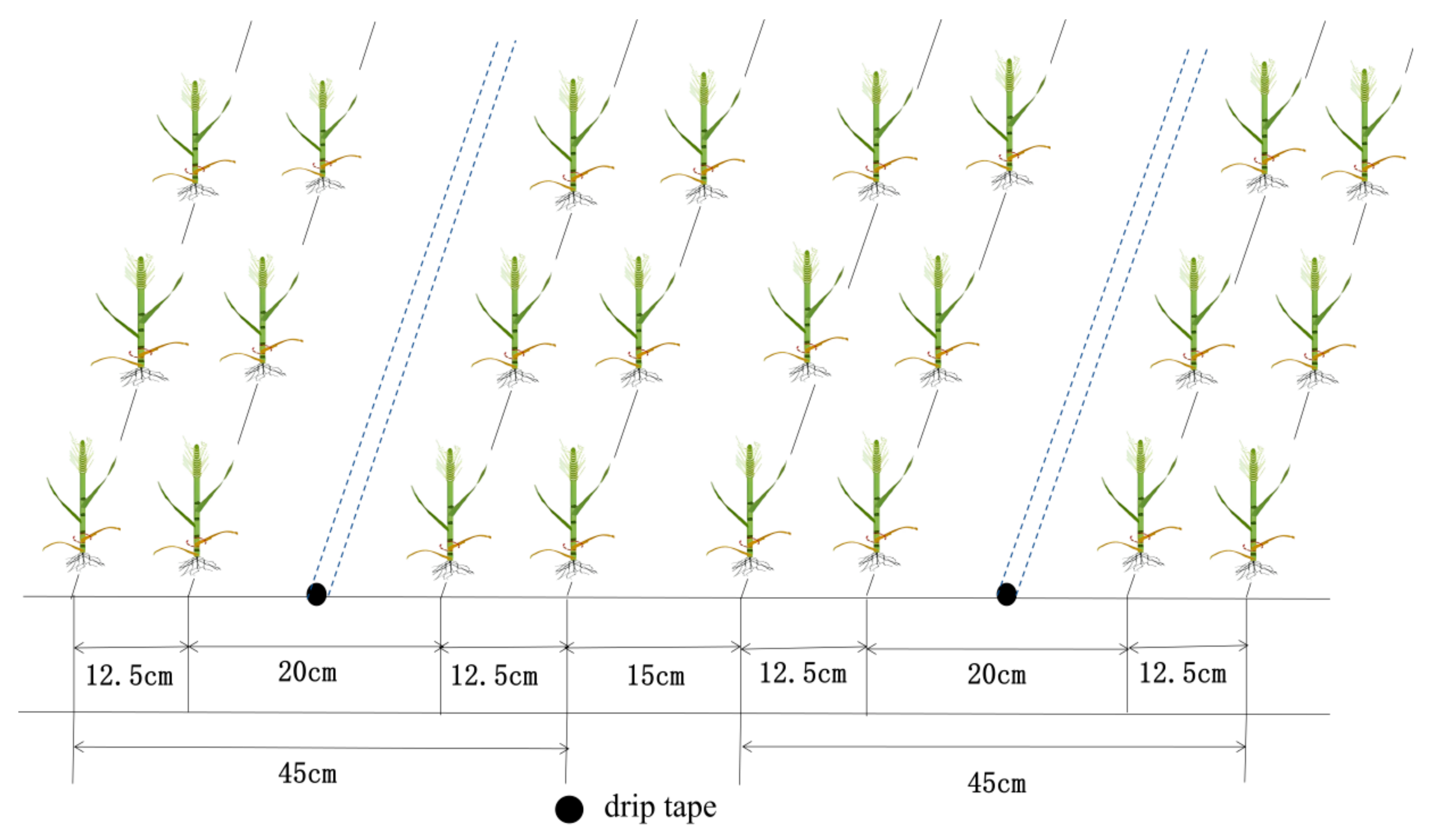


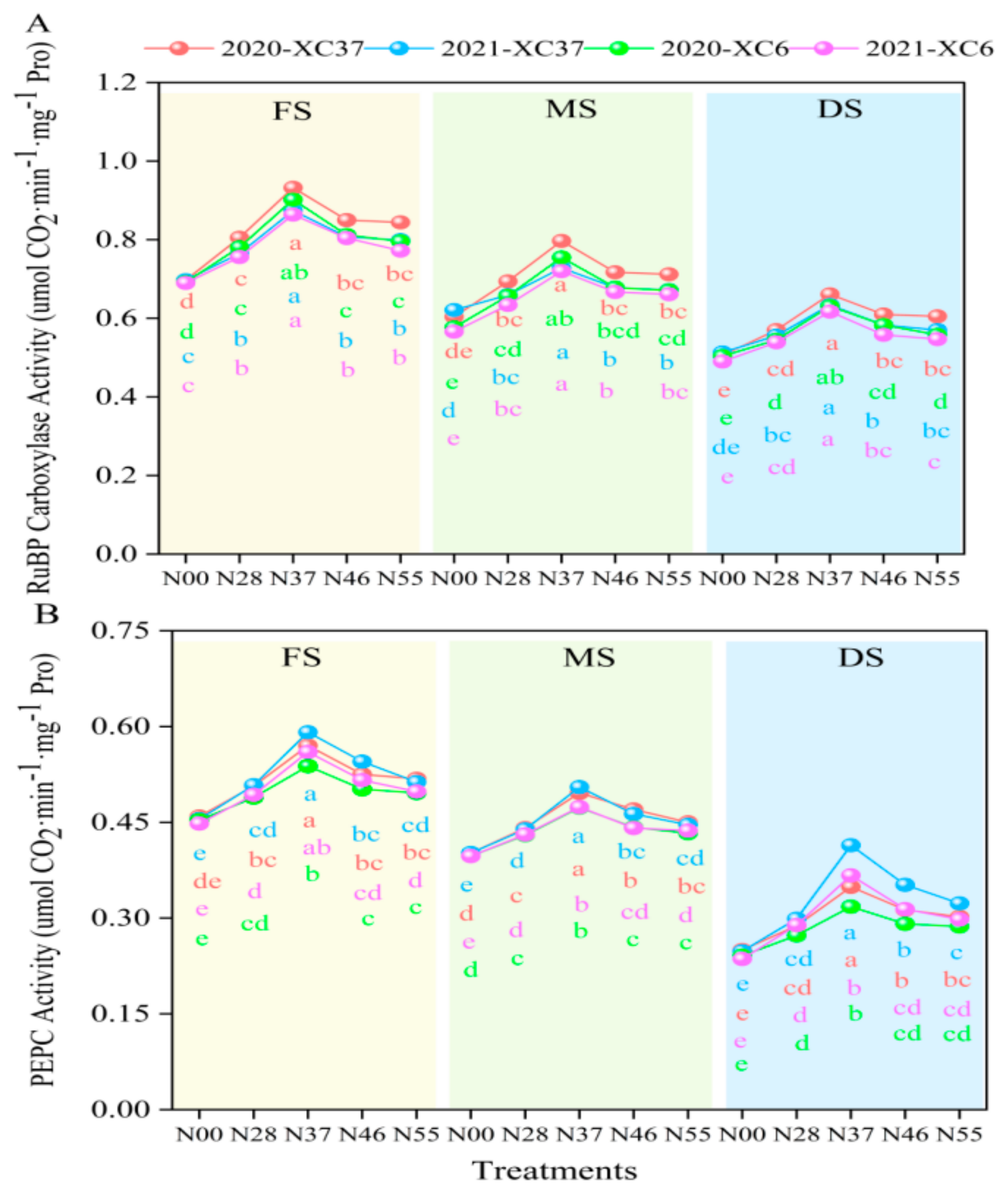

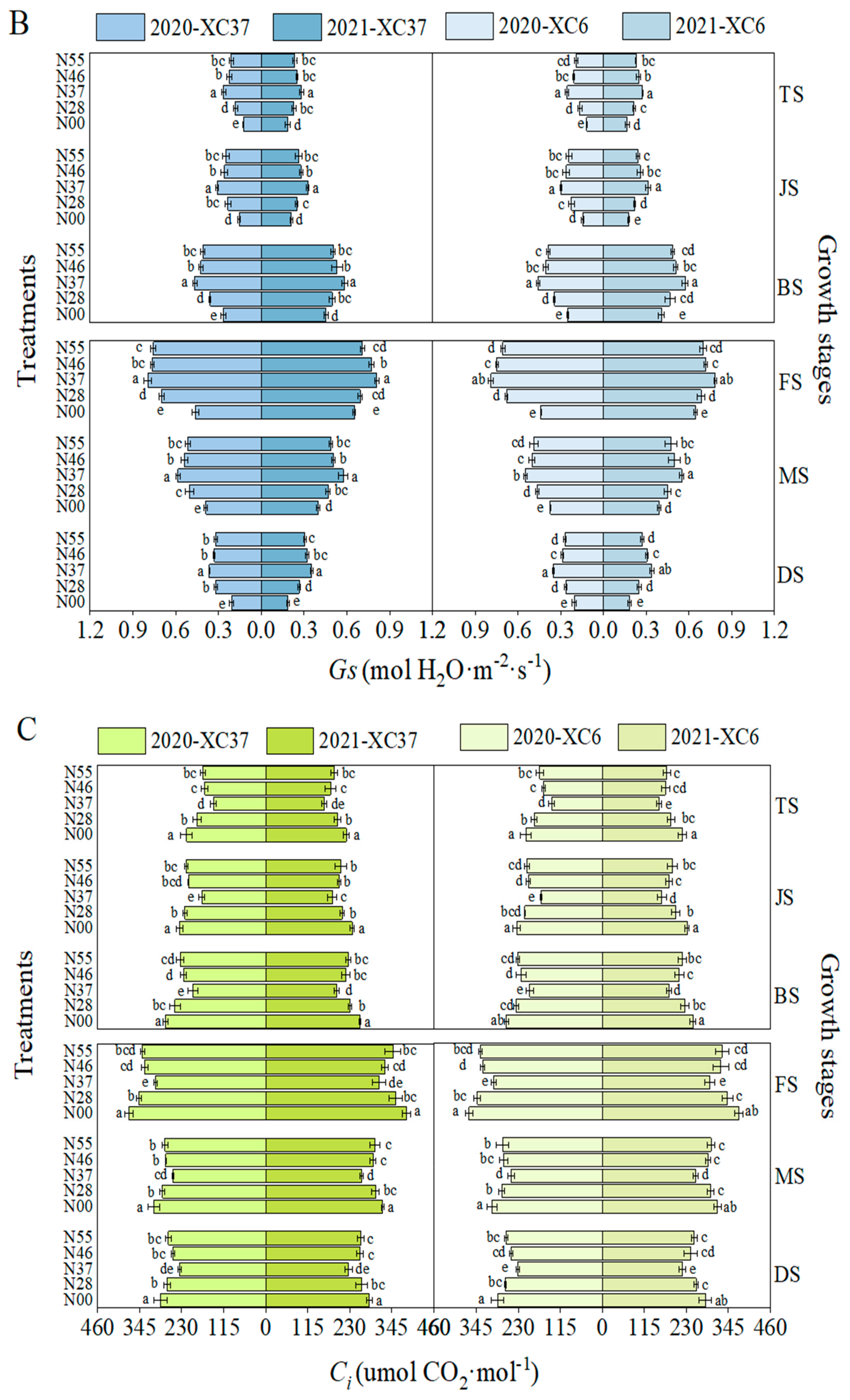
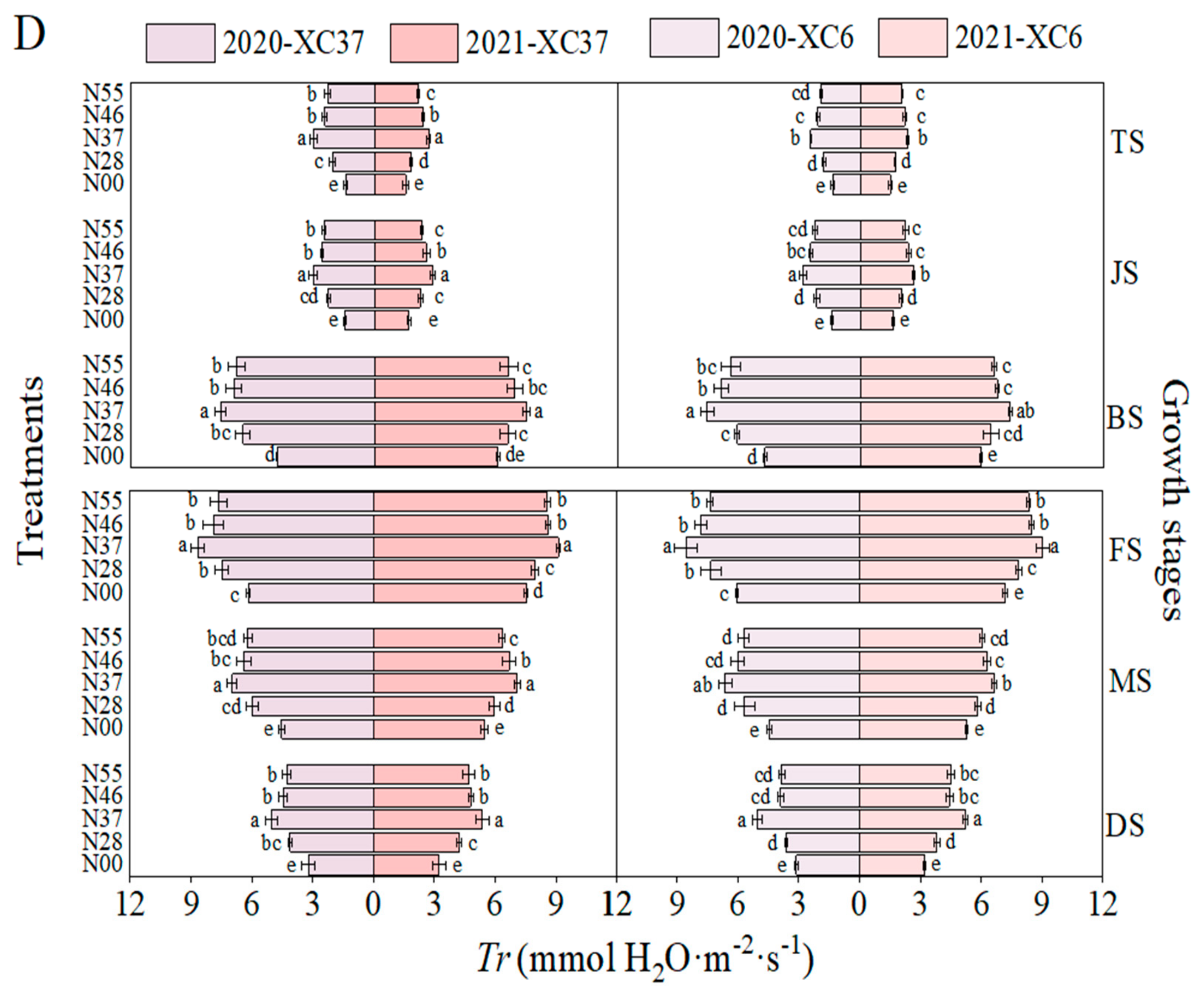

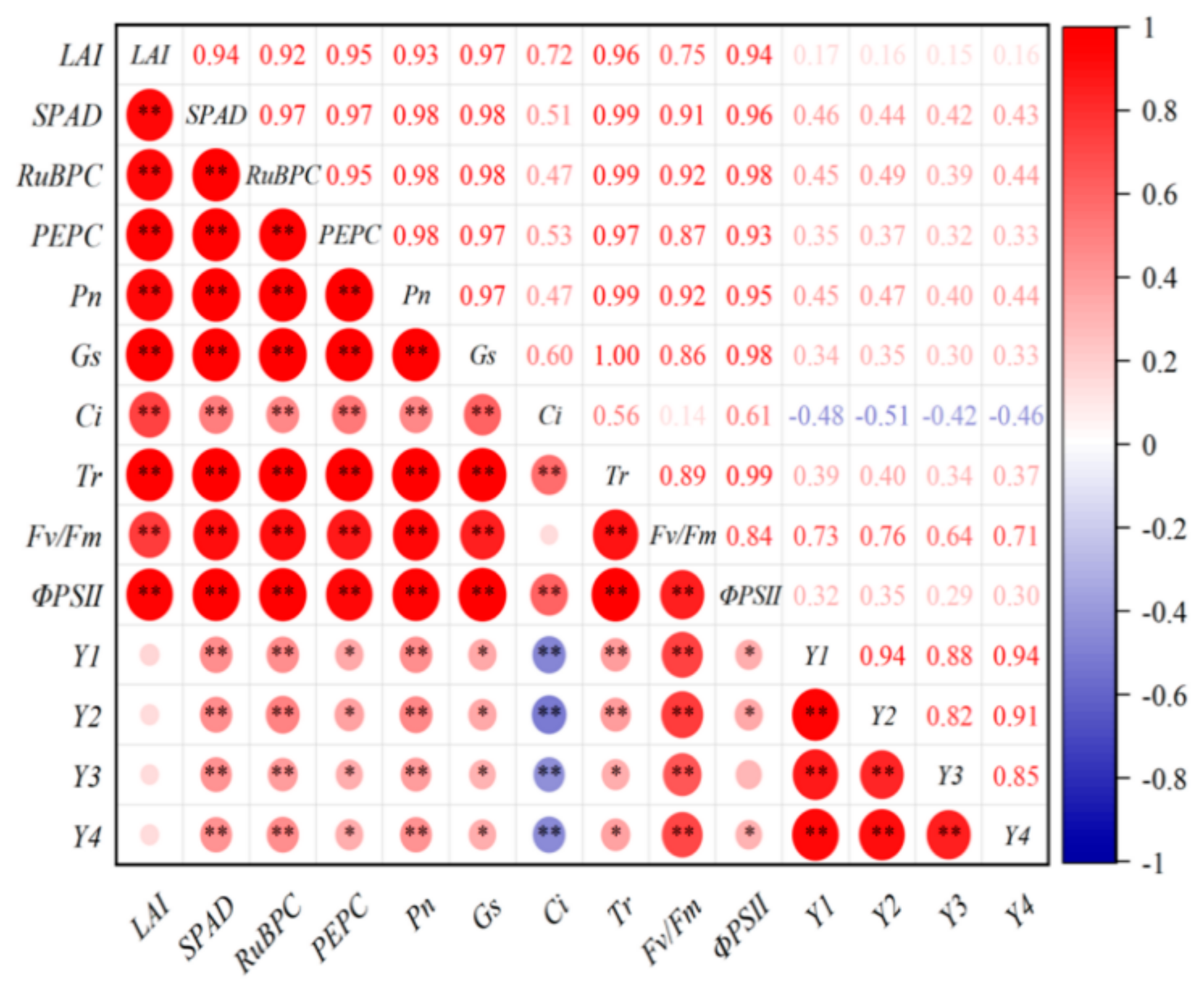
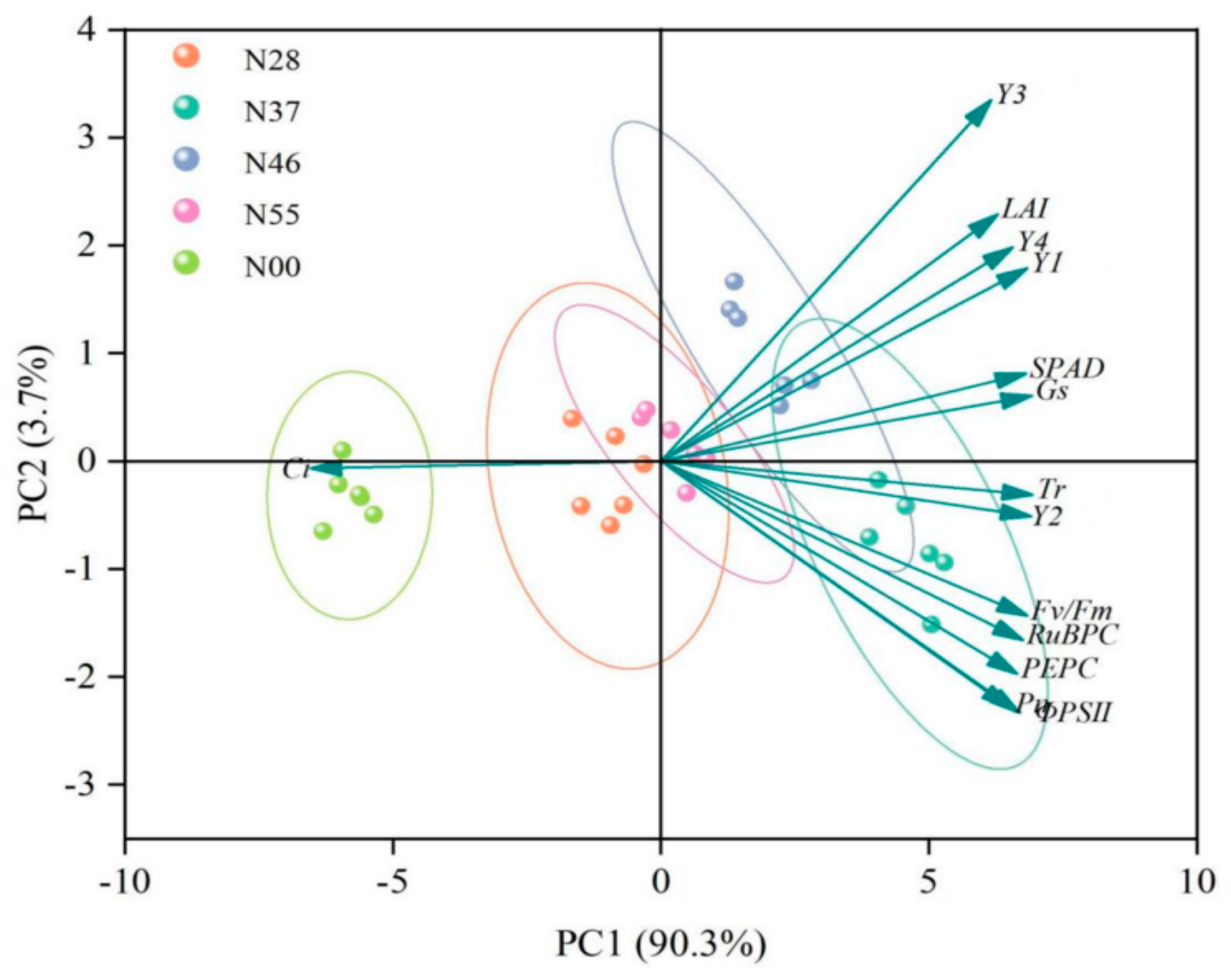
| Year | Total N (g·kg−1) | Avail. N (mg·kg−1) | Avail. P (mg·kg−1) | Avail. K (mg·kg−1) | Organic (g·kg−1) | Soil Capacity (g·cm−3) | Electrical Conductivity (ds·m−1) | PH |
|---|---|---|---|---|---|---|---|---|
| 2020 | 1.20 | 58.30 | 14.24 | 137.01 | 13.43 | 1.27 | 0.44 | 7.8 |
| 2021 | 1.27 | 55.71 | 15.96 | 132.02 | 12.84 | 1.29 | 0.44 | 7.7 |
| Treatments | Basal Nitrogen Fertilizer (kg·hm−2) | Topdressing Nitrogen Fertilizer (kg·hm−2) | |||
|---|---|---|---|---|---|
| Tillering Stage | Jointing Stage | Booting Stage | Flowering Stage | ||
| N00 (0:0) | 0 | 0 | 0 | 0 | 0 |
| N28 (2:8) | 50 | 40 | 80 | 40 | 40 |
| N37 (3:7) | 75 | 35 | 70 | 35 | 35 |
| N46 (4:6) | 100 | 30 | 60 | 30 | 30 |
| N55 (5:5) | 125 | 25 | 50 | 25 | 25 |
| Years | 2020 | 2021 | |||||||
|---|---|---|---|---|---|---|---|---|---|
| Variety (V) | Treatment (N) | 1000-Grain Weight·(g) | Spike Number (×104·hm−2) | Grain per Spike | Grain Yield (kg·hm−2) | 1000-Grain Weight·(g) | Spike Number (×104·hm−2) | Grain per Spike | Grain Yield (kg·hm−2) |
| XC37 | N00 | 43.08 d | 389.08 d | 33.38 cd | 5444.33 e | 44.67 bc | 389.95 de | 34.49 c | 5664.87 de |
| N28 | 46.22 bc | 409.27 c | 35.25 bc | 6558.08 c | 46.09 abc | 410.21 bc | 35.64 bc | 6509.64 bc | |
| N37 | 48.55 a | 433.93 a | 37.94 a | 7269.17 a | 47.29 a | 436.20 a | 38.36 ab | 7302.18 a | |
| N46 | 47.72 ab | 418.80 bc | 38.06 a | 7206.61 ab | 47.08 a | 415.62 bc | 39.01 a | 7166.48 a | |
| N55 | 46.41 bc | 414.52 bc | 36.26 ab | 6956.17 b | 46.99 a | 412.77 bc | 36.04 abc | 6923.64 ab | |
| XC 6 | N00 | 42.76 d | 384.07 d | 32.91 d | 5364.23 e | 44.24 c | 382.15 e | 34.07 c | 5383.47 e |
| N28 | 45.51 c | 406.14 c | 34.98 bcd | 6208.25 d | 45.93 abc | 403.55 cd | 35.61 bc | 6198.44 cd | |
| N37 | 47.51 ab | 426.05 ab | 36.08 ab | 7194.45 ab | 47.02 a | 425.18 ab | 37.89 ab | 7218.51 a | |
| N46 | 46.89 abc | 413.33 bc | 37.74 a | 7000.70 ab | 46.61 ab | 410.84 bc | 38.23 ab | 6948.61 ab | |
| N55 | 46.08 bc | 408.83 c | 36.03 ab | 6554.42 c | 46.42 ab | 408.65 bcd | 36.67 abc | 6508.78 bc | |
| F | V | ns | * | ns | * | ns | * | ns | * |
| N | ** | ** | ** | ** | ** | ** | ** | ** | |
| N × V | * | ns | * | * | ** | * | * | * | |
| Dependent Variable | Action Factor | Correlation Coefficient | Path Coefficient | Indirect Path Coefficients | |||||
|---|---|---|---|---|---|---|---|---|---|
| X1 | X3 | X6 | X7 | X8 | Total | ||||
| Y1 | X6 | −0.3140 | −0.5580 | −0.2584 | −0.2584 | ||||
| X7 | 0.5320 | 0.7650 | 0.3542 | 0.3542 | |||||
| Y2 | X1 | 0.2380 | 1.3990 | 1.1276 | 0.1945 | 1.3081 | 2.6301 | ||
| X3 | 0.4970 | 1.0150 | 0.8181 | 0.3735 | 0.9856 | 2.1772 | |||
| X6 | −0.3320 | −0.4820 | −0.0670 | −0.1774 | −0.2208 | −0.4651 | |||
| X9 | 0.5030 | 1.0470 | 0.9789 | 1.0166 | 0.4795 | 2.4751 | |||
| Y3 | X1 | 0.2320 | 1.6190 | 1.3049 | 0.2250 | 1.5300 | |||
| X3 | 0.4850 | 0.8950 | 0.7214 | 0.3294 | 1.0507 | ||||
| X6 | −0.3170 | −0.3850 | −0.0535 | −0.1417 | −0.1952 | ||||
| X9 | 0.5050 | 1.3270 | 1.2407 | 1.2885 | 0.6078 | 3.1370 | |||
| Y4 | X1 | 0.2300 | 1.3360 | 1.0768 | 0.1857 | 1.2625 | |||
| X3 | 0.4780 | 0.8050 | 0.6488 | 0.2962 | 0.9451 | ||||
| X6 | −0.3300 | −0.4890 | −0.0680 | −0.1800 | −0.2479 | ||||
| X9 | 0.4910 | 1.1830 | 1.1061 | 1.1487 | 0.5418 | 2.7966 | |||
Disclaimer/Publisher’s Note: The statements, opinions and data contained in all publications are solely those of the individual author(s) and contributor(s) and not of MDPI and/or the editor(s). MDPI and/or the editor(s) disclaim responsibility for any injury to people or property resulting from any ideas, methods, instructions or products referred to in the content. |
© 2025 by the authors. Licensee MDPI, Basel, Switzerland. This article is an open access article distributed under the terms and conditions of the Creative Commons Attribution (CC BY) license (https://creativecommons.org/licenses/by/4.0/).
Share and Cite
Zhang, Y.; Wang, H.; Wang, R.; He, F.; Jiang, G.; Xu, J. Improvement of the Photosynthetic Characteristics and Yield of Wheat by Regulating the Proportion of Nitrogen Fertilizer Base and Topdressing. Agronomy 2025, 15, 899. https://doi.org/10.3390/agronomy15040899
Zhang Y, Wang H, Wang R, He F, Jiang G, Xu J. Improvement of the Photosynthetic Characteristics and Yield of Wheat by Regulating the Proportion of Nitrogen Fertilizer Base and Topdressing. Agronomy. 2025; 15(4):899. https://doi.org/10.3390/agronomy15040899
Chicago/Turabian StyleZhang, Yaoyuan, Haiqi Wang, Rongrong Wang, Fangfang He, Guiying Jiang, and Jianwei Xu. 2025. "Improvement of the Photosynthetic Characteristics and Yield of Wheat by Regulating the Proportion of Nitrogen Fertilizer Base and Topdressing" Agronomy 15, no. 4: 899. https://doi.org/10.3390/agronomy15040899
APA StyleZhang, Y., Wang, H., Wang, R., He, F., Jiang, G., & Xu, J. (2025). Improvement of the Photosynthetic Characteristics and Yield of Wheat by Regulating the Proportion of Nitrogen Fertilizer Base and Topdressing. Agronomy, 15(4), 899. https://doi.org/10.3390/agronomy15040899





